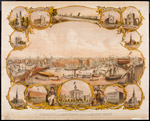A Bird's Eye View of Pre-Fire Chicago
We, of the earlier time, saw the things about us through a tenuous and almost colorless atmosphere--for we lived in a present without a past.
Frederick Francis Cook, Bygone Days in Chicago
Chicago just before the fire was much like the catastrophe that befell it. The city struck many as a titanic natural force: unpredictable, unstoppable, all-consuming, and impossible to ignore. To try to get a precise sense of what pre-fire Chicago was like is to misunderstand it, because what the city embodied above all else was change.
As people would soon remark about the fire, there was no easy way to "see" Chicago or to capture it accurately in words, since it was a titanic work-in-progress comprising such a volume and variety of experience. One can still try to go back in time and attempt to reconstruct a bird's-eye view. What you would see, of course, would depend on how high you flew.
From a lofty height that enabled you to perceive the expanse of land and water that surrounded the city, you would note above all pre-fire Chicago's critical position as the nexus between the manufacturing East and the agricultural West in a nation that was establishing its eminence in an international economy. This position explains why Chicago's boosters were correct when they argued that, the fire notwithstanding, its future was never in doubt. The city was not an isolated metropolis that accidentally appeared out of nowhere but a critical piece in an interdependent system--defined by an ever-increasing flow of people, money, goods, and information--that created it in the first place and, after the fire, would rebuild it with an astonishing rapidity that seemed to recapitulate its already breathtaking history in a kind of historical fast-forward.
From a few hundred feet, one would see the varied enterprises that animated the city: the lakefront and the branches of the Chicago River that divided Chicago into its North, South, and West Divisions, all busy with commercial traffic; the trunk railroads that converged in this place and by which, since 1869, it was linked to both coasts; the many grain elevators that together could hold almost twelve million bushels; the more than 1,100 factories, of which the McCormick Reaper Works just north of the Main Branch of the river near the lake was perhaps the most prominent; commercial exchanges such as the Board of Trade in the downtown Chamber of Commerce building; wholesale houses including the grocer Z. M. Hall in the five-story Lind Block by the Randolph Street Bridge; new State Street retail concerns such as Booksellers' Row and the Field and Leiter department store; and the city within a city that was the Union Stock Yard, which had opened on Christmas Day of 1865 south of the city limits and through whose gates passed well over three million head of livestock in the year of the fire.
One could also make out certain prominent structures, key among them the Court House, in the South Division's central business district, on the same site as the current City Hall and Cook County Building. The Court House contained virtually all municipal and county offices and records, as well as the jail. Among the most striking buildings in the North Division were the limestone Gothic Water Tower and Pumping Station at Pine Street (now North Michigan Avenue) and Chicago Avenue, which were dedicated with great fanfare in 1867.
If your viewpoint was a little lower down, in the top of the Court House cupola, to which photographer Alexander Hesler climbed in 1858 to record an eleven-image Chicago panorama, you would notice the contrasting forms and styles in commercial and domestic architecture. You would also observe certain startling juxtapositions. In the North Division there was little separation between the homes of the Yankee elite and those of the German workers who far outnumbered them. Just across the river in the West Division, dwellings and factories were in close proximity. Here laborer Patrick O'Leary, his wife Catherine, and their five children lived in the rear section of a two-part wooden cottage. Behind their dwelling on the same lot, only a little more than a mile from the center of town, was the barn from which Mrs.O'Leary conducted her neighborhood milk business. The O'Learys were hardly Chicago's worst off. In the South Division by the gas works was "Conley's Patch," one of the most squalid and vice-ridden of several slum districts in the city.
If you were particularly observant, you would notice two more things. The first would be the amount of wood all around, whether in the great stacks of raw lumber in yards along the South Branch of the Chicago River, the 57 miles of wood-paved streets (out of a total of 88 miles of paved streets in all, leaving almost 450 miles unpaved altogether) and 561 miles of wooden sidewalks, and the tens of thousands of wooden or wood-trimmed structures. And, if you took your bird's-eye view in the first days of October of 1871, your Indian Summer revery would be unsettled by your worrisome awareness that barely an inch-and-a-half of rain had fallen since Independence Day, and that the city of Chicago was dry--very dry.










